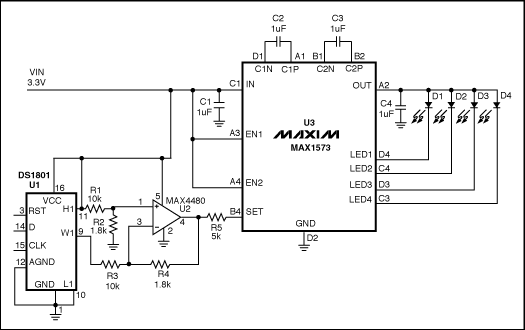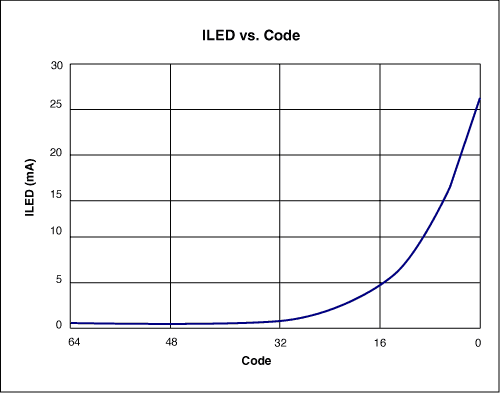The circuit of Figure 1 is designed for portable-power applicaTIons that require white LEDs with adjustable, logarithmic dimming levels. It drives as many as four white LEDs from a 3.3V source, and adjusts the total LED current from 1mA to 106mA in 64 steps of 1dB each. The driver is a charge pump that mirrors the current ISET (sourced from U3's SET terminal), to produce a current of (215ISET ± 3%) through each LED. Internal circuitry maintains the SET terminal at 0.6V.

Figure 1. This circuit provides a logarithmic-dimming capability for white LEDs.
To control the LED brightness, op amp U2 monitors the difference between the high-side voltage and the wiper voltage of digital potenTIometer U1. The op amp then mulTIplies that voltage by a gain to set the maximum output current. Zero resistance at the pot's W1 terminal corresponds to minimum LED current, and therefore minimum brightness. Because the SET voltage is fixed (at 0.6V), any voltage change at the left side of R5 changes ISET, and the resulTIng change in LED currents changes their brightness level. R5 sets the maximum LED current:
R5 = 215x0.6 / ILED (Desired)
where ILED is the current through one LED.
U1 is a digital potentiometer with logarithmic taper and an analog-voltage wiper for which each tap corresponds to 1dB of attenuation between H1 and W1 (pins 11 and 9). It contains two pots controlled by a 16-bit code via a 3-wire serial interface. To set the LED current, drive RST-bar high and clock 16 bits into the D terminal of U1, starting with the LSB. Each pulse at CLK enters a bit into the register.
The circuit uses only one pot, so bits 0 through 7 are "don't care" bits. Bits 8 through 14 determine the wiper position: bits 8 through 13 set the code, and bit 14 is "mute." (Logic one at bit 14 produces the lowest-possible output current by setting the left side of R5 at approximately 0.599V.) After entering all 16 bits, enter the code and change the brightness level by driving RST-bar high. Figure 2 shows the logarithmic relationship between an LED current and the pot's input code.

Figure 2. LED current vs. input code for the Figure 1 circuit.
This design idea appeared in the June 10, 2004 issue of EDN magazine.
Drivers with dimming capability can dim the LED light output over the full range from 100% to 0%. Dimming drivers can dim LEDs by reduction in the forward current, pulse width modulation (PWM) via digital control, or more sophisticated methods. Most dimming drivers operate using the PWM method. With this method, the frequency could range from a hundred modulations per second to as high as hundreds of thousands of modulations per second, so that the LED appears to be continuously lighted without flicker.
At present, the most commonly used LED dimming power: LED thyristor dimming power, LED 0 / 1-10V dimming power, PWM dimming power supply. Other dimming works by controlling the current and voltage, the frequency of the output to achieve the LED dimming function.
0-10V/PWM/RX Dimming Driver
10V Dimmable Led Driver,Led Pwm Driver,Constant Current Driver Dimmable
ShenZhen Fahold Electronic Limited , https://www.fahold.com
